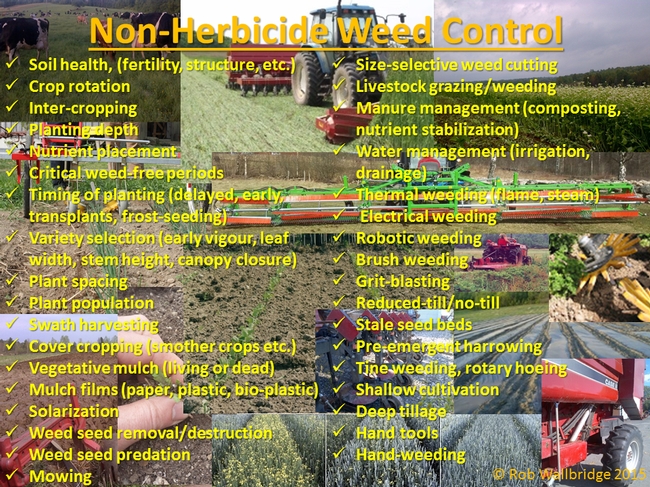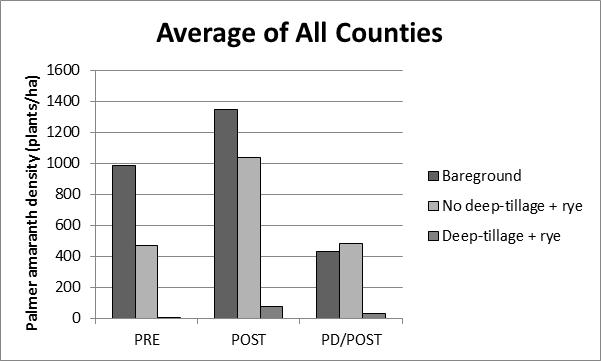Spray and pray? Squirt and look? Burn baby burn?
Besides the Beavis and Butthead laughs (Heh. Heh-heh. Heh) that usually come when you tell someone you are a weed scientist, is the expectation that you advocate for the use of herbicides as the sole weed management strategy in any given system. I do evaluate chemical weed control (I won't deny it) and, surely, there are those who like to engage in recreational herbicide applications on the weekends; however, weed science is a very varied discipline with investigators that study weed biology and ecology, weed evolution, and weed suppression using biological, cultural, and physical tools.
I was very happy to see the following image (Figure 1) posted on Rob Wallbridge's Twitter account (@songberryfarm). Rob and his wife own and operate Songberry Farm (http://www.songberry.ca/) in Canada. They grow over "200 different varieties of 20 more than 20 different types of vegetables" organically and are often asked how they manage weeds without using herbicides. Rob compiled an impressive list of strategies that 1) growers currently use, or else 2)strategies that have been/are being explored (Figure 1).
Figure 1. A figure of non-herbicide weed control strategies for use in agriculture. Image courtesy of Rob Wallbridge.
Now I know what you are thinking, some of those are too expensive, too complicated, or otherwise too impractical for X, Y and Z to adopt. And you would be right. Not everything on this list is appropriate for everyone, or even most everyone. But many of these strategies are employed, regularly, and not just by organic growers. And many more could/should be used more frequently in some contemporary/conventional farming systems to increase diversity in weed control strategies, which is a standard recommendation for preventing/mitigating the development of herbicide resistance.
An example: Non-herbicide weed control practices in SE cotton production
Let me share with you the results from studies conducted in the SE US looking at deep tillage and cover cropping for the management of glyphosate-resistant Palmer amaranth. (For the record, this information was originally posted in a blog at this site on May 3, 2013.)
In 2010/2011, three fields managed by grower/co-operators were selected for use in a study to evaluate the effectiveness of deep tillage and a rye cover crop for managing severe glyphosate-resistant (GR) Palmer amaranth in conventional cotton. Three treatments, which included:
1) cotton strip-tilled into winter weed residue [bare ground],
2) cotton strip-tilled into a rolled (dead) rye cover crop [no deep tillage + rye], and
3) cotton strip-tilled into a rolled (dead) rye cover crop planted on deep-tilled soil [deep-tillage + rye]
were established at each site. Each treatment plot encompassed an area > 1 Ha in size. Deep-tillage (to a depth of 32 cm or 13 inches) using moldboard plows occurred in autumn/winter of 2010, prior to planting rye. Winter rye was planted at 90-120 kg/Ha (1.5-2 bu/A) in order to maximize biomass production (>4000 kg/Ha or 3500 lbs/A). For the record, this was not an organic system, so we did use herbicides as a tool in our total weed management program. This included the use of 1) pre-plant/pre-emergence (PRE), 2) post-emergence (POST) and 3) post-directed (PD or layby) herbicides as directed by their local extension agents; each plot at each site received the same herbicides, regardless of tillage or cover crop. As a consequence, we had three weed control strategies that varied in their intensity: herbicide only, a rolled rye cover crop plus herbicides, and deep-tillage plus a rolled rye cover crop plus herbicides.
Results from our study showed that the addition of deep-tillage and a rolled rye cover crop to our cotton system improved season-long Palmer amaranth control (Figure 2). GR Palmer amaranth densities were greatest (500-1300 plants /ha) when herbicides were applied as the sole strategy for weed control; densities were lowest (10-80 plants/ha) when deep tillage, a rye cover crop and a herbicide program were all used together.
Figure 2. Weed control in three cotton production systems following PRE, POST, and layby herbicide applications. GR Palmer amaranth densities were greatest (500-1300 plants /ha) when herbicides were applied as the sole strategy for weed control; densities were lowest (10-80 plants/ha) when deep tillage, a rye cover crop and a herbicide program were all used together.
Might we have achieved the same level of control if we had included more/alternate herbicides in our production system? Possibly. But the point of this blog post is to show that non-chemical control strategies can/do have a place in modern agriculture. And that public institutions are evaluating these techniques for use in a variety of crops. A search of the Internet will yield a number of University extension pages describing the proposed/realized utility on non-chemical weed control strategies such as crop rotation, robotic weeding, soil solarization, flame weeding, among others. Reviews of non-chemical weed control strategies can be found here and here.
Selection and timing are everything when it comes to weed control.
We often talk about how to maximize weed control when using herbicides; many of the same principles apply with non-chemical strategies as well. In essence, our recommendations boil down to two main considerations: 1) choosing the appropriate strategies for your cropping system/weedy pests and 2) applying those strategies at the appropriate time. For example: vining crops like melons have a very short window available for mechanical weed control using cultivation; flaming may not effectively damage the growing points of grasses, which are less exposed than the meristems of broadleaf species; larger weeds are more difficult to remove by hand and plant regrowth may occur if roots or stems are allowed to remain in the field.
Just like herbicides, non-chemical control strategies need to be used responsibly. Also, failures may occur.
Like herbicides, these programs and protocols are not infallible; any weed management practice can fail, necessitating the need for alternate control measures. Similarly, when not diversified, non-chemical practices exert their own selection pressures on weeds, leading to the development of weed communities adapted to a given strategy (think crop mimics in hand-weeded rice). Remember, variety is key when it comes to weed control, chemical or otherwise.

